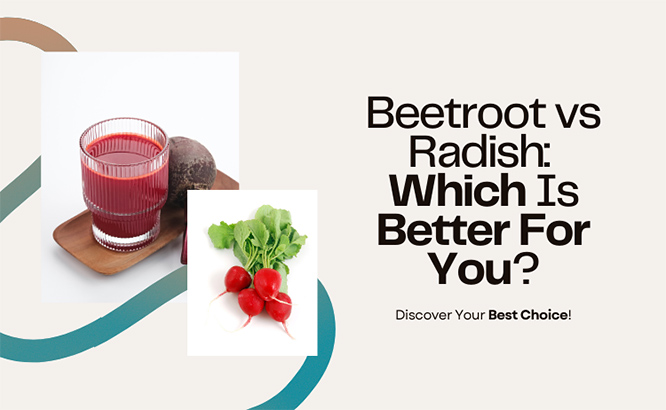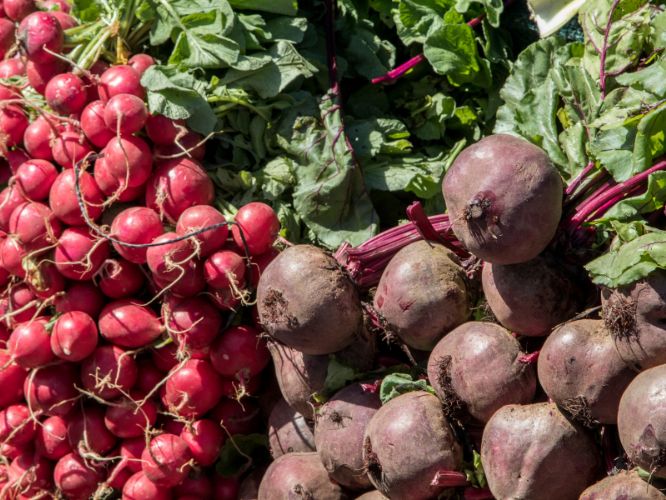
Beets (or beetroot, if you’re in the UK) and radishes might look somewhat similar at first glance—both are round, root vegetables, and both come in vibrant red varieties. But that’s where the similarities end. These two veggies are not the same.
Beets have a naturally sweet, earthy taste and a smooth texture when cooked, while radishes are crisp, peppery, and often eaten raw for their refreshing bite.
Nutritionally, they also have distinct differences—beets are higher in natural sugars and carbs, while radishes are incredibly low in calories and carbs, making them a go-to for low-carb eaters.
And if you’re wondering whether they’re related, the answer is no. Beets belong to the Amaranthaceae family, which includes spinach and chard, while radishes are part of the Brassicaceae family, alongside mustard greens, cabbage, and broccoli. So, even though they’re both root vegetables, they come from entirely different plant families.
Table of Contents
Beets vs. Radishes: Nutrition and Health Benefits
Beets and radishes are both packed with nutrients, but they offer very different benefits. Let’s break it down and see which one is better depending on your health goals.
Nutrient Comparison: Beets vs. Radishes
Both vegetables are nutritious, but they shine in different areas. Beets are higher in certain minerals and antioxidants, while radishes provide unique plant compounds.
| Nutrient | Beets (per 100g) | Radishes (per 100g) | Which Has More? |
|---|---|---|---|
| Calories | ~43 kcal | ~16 kcal | Radishes (fewer calories) |
| Carbs | ~9.6g | ~3.4g | Beets (more energy) |
| Sugar | ~7g | ~1.9g | Beets (naturally sweeter) |
| Fibre | ~2.8g | ~1.6g | Beets (more fibre) |
| Vitamin C | ~4.9mg | ~14.8mg | Radishes (3x more) |
| Folate (B9) | ~109µg | ~25µg | Beets (4x more) |
| Iron | ~0.8mg | ~0.3mg | Beets (more) |
| Calcium | ~16mg | ~25mg | Radishes (more) |
| Potassium | ~325mg | ~233mg | Beets (more) |
| Magnesium | ~23mg | ~10mg | Beets (more) |
| Antioxidants | Betalains (anti-inflammatory) | Isothiocyanates (may help fight cancer) | Different types |
Beets are packed with folate, which supports cell growth and red blood cell production. They’re also rich in potassium, iron, and magnesium, all essential for heart health and muscle function. However, they contain more carbs and natural sugars, making them a higher-energy option.
Radishes, on the other hand, are lower in carbs and sugar, making them a great choice for low-carb or keto diets. They’re also higher in vitamin C, which boosts immunity and supports skin health, and contain unique plant compounds that may have anti-cancer properties.

Health Benefits of Beets vs. Radishes
Now that we’ve compared their nutrients, let’s see how they impact your health.
| Health Benefit | Beets | Radishes |
|---|---|---|
| Heart Health & Circulation | Rich in nitrates, which may help lower blood pressure and improve circulation. | Contains potassium, which supports heart health, but lacks nitrates. |
| Digestion & Gut Health | Higher in fibre (~2.8g per 100g), promotes regular bowel movements and supports gut bacteria. | Lower in fibre (~1.6g per 100g) but contains compounds that support liver function, which aids digestion. |
| Weight Loss | Provides fibre to help keep you full, but higher in calories and natural sugars. | Very low in calories and carbs, making it great for weight loss. |
| Immunity & Skin Health | Contains vitamin C and antioxidants, but in lower amounts. | Higher in vitamin C, which helps boost immunity and supports skin health. |
| Cancer-Fighting Compounds | Contains betalains, which may help reduce oxidative stress and lower cancer risk. | Rich in isothiocyanates, compounds studied for their anti-cancer properties. |
| Antioxidants & Anti-Inflammatory Effects | Betalains also have strong anti-inflammatory and antioxidant properties. | Contains isothiocyanates and vitamin C, both of which have antioxidant effects. |
| Bone Health | Contains magnesium and calcium, but in smaller amounts. | Higher in calcium, which supports strong bones. |
- Beets are great for heart health, digestion, and reducing inflammation.
- Radishes are better for immune support, weight loss, and liver health.
Which One Is Healthier Overall?
Beets and radishes each have their strengths, so the healthier choice depends on what you’re looking for.
✔ For more vitamins and antioxidants → Beets win with their higher folate, iron, and betalains.
✔ For a low-calorie, low-carb option → Radishes are the better pick.
✔ For heart health and circulation → Beets are more beneficial thanks to their natural nitrates.
✔ For an immune boost and more vitamin C → Radishes come out on top.
The best choice? Eat both! They complement each other well, so including both in your diet gives you the best mix of nutrients and health benefits.
Taste, Texture, and How to Eat Them
Beets and radishes couldn’t be more different when it comes to taste and texture. While they’re both root vegetables, their flavours and how they’re used in the kitchen vary quite a bit.
What Do They Taste Like?
- Beets (Beetroot) – Naturally sweet and earthy, with a deep, almost “groundy” flavour. Cooking enhances their sweetness and makes them tender.
- Radishes – Peppery, crisp, and slightly spicy, especially when eaten raw. Some varieties are milder, but overall, they bring a sharp bite.
How to Eat Them
Both beets and radishes are incredibly versatile, but how you eat them depends on the texture and flavour you prefer.
| How to Eat | Beets (Beetroot) | Radishes |
|---|---|---|
| Raw | Shredded into salads for a slight crunch | Sliced in salads, sandwiches, or eaten whole with salt |
| Cooked | Roasted, boiled, or steamed to bring out sweetness | Roasted to mellow the sharpness and bring out a slightly sweeter, softer flavour. |
| Pickled | Adds a tangy contrast to dishes | Adds a zesty crunch to tacos, grain bowls, and sandwiches |
| Juiced | Often blended into smoothies for a nutrient boost | Not commonly juiced due to strong peppery flavour |
Can You Eat Beets and Radishes Together?
Yes! Their contrasting flavours—sweet from beets and peppery from radishes—balance each other beautifully. Try tossing them together in salads, roasting them for a colourful and flavourful side dish, or even pickling them together for a tangy, crunchy mix.
Beet Greens vs. Radish Leaves: Are They Edible?
Yes! Both beet greens and radish leaves are completely edible and surprisingly nutritious. But which one is better? Let’s compare.
Nutritional Benefits of Beet and Radish Greens
Beet greens are often overlooked, but they’re packed with vitamins A, C, and K, along with iron, calcium, magnesium, and fibre—making them nutritionally similar to spinach. They have a slightly earthy taste with a hint of bitterness, especially when eaten raw.
Radish leaves are an excellent source of vitamin C and contain higher levels of calcium, potassium, and antioxidants compared to radish roots. They also contain non-flavonoid polyphenols and glucosinolates, compounds that support digestion, liver function, and may have anti-cancer properties. Their flavour is sharper and more peppery, similar to arugula or mustard greens.
Beet Greens vs. Radish Leaves: Nutritional Comparison
| Nutrient | Beet Greens | Radish Leaves |
|---|---|---|
| Vitamin A | High (supports vision & immunity) | Moderate |
| Vitamin C | Good source | Excellent source (boosts immunity & skin health) |
| Vitamin K | High (important for blood clotting & bone health) | Moderate |
| Iron | High (helps prevent anaemia) | Moderate |
| Calcium | Good source (supports bones & muscles) | Higher than beet greens |
| Magnesium | Present (supports muscle & nerve function) | Higher than roots, supports metabolism |
| Potassium | Moderate (supports heart health) | Higher than beet greens (important for heart & muscle function) |
| Fibre | Good source (supports digestion & gut health) | Higher than radish roots (supports digestion & liver health) |
| Antioxidants | Contains flavonoids & betalains | Rich in glucosinolates & non-flavonoid polyphenols |
| Flavour | Earthy, slightly bitter | Peppery, sharp |
How to Use Beet and Radish Greens in Your Meals
- Beet Greens: Use them like spinach—sautéed with garlic, added to soups, blended into smoothies, or tossed into salads. Their slightly bitter taste pairs well with citrus or balsamic vinegar.
- Radish Leaves: Best used fresh in salads, pestos, or stir-fries. Their peppery bite makes them a great substitute for arugula or mustard greens. Cooking them can tone down the sharpness.
If you have both on hand, try mixing them in a sauté or pesto for a balance of earthy and peppery flavours. No need to waste those leafy tops!
Final Thoughts: Should You Eat Beets or Radishes?
Both beets and radishes bring unique benefits to the table, so the best choice depends on your needs. Beets are rich in folate, iron, and antioxidants like betalains, making them great for heart health, circulation, and inflammation support. They also provide more fibre, which helps digestion.
Radishes, on the other hand, are low in calories and carbs but packed with vitamin C and disease-fighting compounds. Their peppery crunch makes them a refreshing addition to meals, and they contain glucosinolates and isothiocyanates, which have potential anti-cancer properties.
For a well-rounded diet, why not enjoy both? Their contrasting flavours and textures complement each other, and together, they offer a powerful mix of nutrients. Whether raw, roasted, or pickled, beets and radishes are two root vegetables worth keeping on your plate.
References:
Nutritional and Phytochemical Characterization of Radish (Raphanus sativus): A Systematic Review























